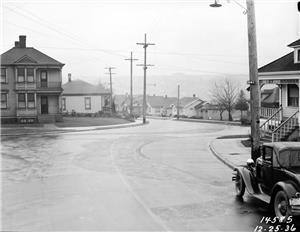In February 1948, the Seattle Civic Unity Committee denounces restrictive covenants that deny housing to minorities, principally African Americans. These restrictions effectively confine African Americans to the Central Area and a corridor along South Jackson Street, and prevent them from moving to neighborhoods such as Mount Baker, Capitol Hill and Broadmoor.
Real estate developers often included discriminatory language in the original plans for subdivisions. Buyers had to agree to the language if they wanted to buy property. Subsequent buyers also had to agree to the terms and sometimes were unaware of them since deeds referred to the covenants without specifying them. The committee found that "a majority of residential property is restricted by racial covenants or 'gentlemen's agreements.'"
The committee presented the following examples of how Seattle realtors discriminated against minorities:
November 1927 (Capitol Hill) - The parties... agree each with the others that no part of the lands owned by them shall ever be used or occupied by or sold, conveyed, lessed, rented or given to Negroes or any person of Negro blood.April 1928 (Broadmoor) - No part of said property hereby conveyed shall ever be used or occupied by any Hebrew or by any person of the Ethioipian, Malay or any Asiatic race...
February 7, 1947 (Queen Anne Park, Laguna Vista, Rayville, Carleton Park) - No person or persons of Asiatic, African or Negro blood, lineage or extraction shall be permitted to occupy a portion of said property, or any building thereon, except domestic servant or servants may be actually and in good faith employed by white occupants of said premises.
October 31, 1947 (Laurelhurst, Victory Heights, Green Lake Circle) - No person of other than the Caucasian race shall use or occupy any building or lot except as servants domesticated with any owner or tenant.
Until 1950, Article 34 of Code of Ethics for realtors in Seattle included:
A Realtor should never be instrumental in introducing into a neighborhood a character of property or occupancy, members of any race or nationality, or any individual whose presence will clearly be detrimental to property values in that neighborhood.
In May 1948, the U.S. Supreme Court decided in Shelley v. Kraemer that, while the constitution did not prevent private individuals from creating restrictive covenants, the Fourteenth Amendment's equal protection clause prohibited such covenants from being enforced through the courts or other government action. This left open the possibility of voluntary agreements between realtors and homeowners that allowed housing discrimination to continue. In 1964, Seattle voters rejected a referendum that prohibited housing discrimination.
In April 1968, the city council passed an open housing ordinance, making restrictive covenants illegal.

